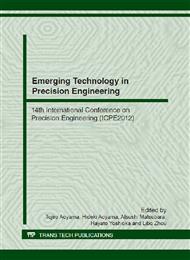[1]
M. Otsu, H. Miura; Three-Dimensional Forming of Sheet Metal, Journal of Japan Laser Processing Society, Vol.10, No.3, (2003), pp.238-242.
Google Scholar
[2]
T. Ueda, K. Yamada, S. Oikawa, A. Hosokawa; Basic Study on Laser Forming, Journal of the Japan Society of Precision Engineering, Vol.67,No.2, (2001), pp.300-305.
DOI: 10.2493/jjspe.67.300
Google Scholar
[3]
M. Saeki, A. Sakakibara, K. Hosokawa, Simulation of Laser Forming-1st Report, Effect of Plate Thickness and Beam Diameter on Bending Direction-, Journal of the Japan Society of Precision Engineering, Vol.74,No.2, (2008), pp.160-165.
DOI: 10.2493/jjspe.74.160
Google Scholar
[4]
Y. Namba, T. Katayama, Three Dimensional Thermal Elastic-plastic Analysis of Laser Forming Process, Journal of the Japan Society of Precision Engineering, Vol. 65,No.9, (1999), pp.1330-1334.
DOI: 10.2493/jjspe.65.1330
Google Scholar
[5]
M. Osawa, T. Hatayama, T. Okubo, Y. Uchiyama, Fundamental Study on Micro-forming by Laser Beam, Annual Report Research Institute for Technology No. 20 Tokyo Denki University, No.20, (2001), pp.113-118.
Google Scholar
[6]
M. Osawa, Y. Itoh, H. Sato, Plastic forming of micro parts by laser beam, Annual Report Research Institute for Technology No. 23 Tokyo Denki University, No.23, (2004), pp.95-100.
Google Scholar
[7]
M. Osawa, H. Ichikawa, H. Sato, Plastic Deformation of Thin Metal Sheet by Laser Beam, Annual Report Research Institute for Technology No. 25 Tokyo Denki University, No.25, (2006), pp.95-100.
Google Scholar
[8]
T. Miyazaki, M. Saito, T. Tokunaga, T. Misu, S. Yoshioka; Diode Laser Forming of Thin Metal Plate Using Pre-bending Effect, Journal of the Japan Society of Precision Engineering, Vol.68,No.5, (2002), pp.700-704.
DOI: 10.2493/jjspe.68.700
Google Scholar
[9]
T. Misu, Y. Sano, T. Miyazaki, S. Yoshioka, T. Tokunaga, Y. Tanaka; Laser Bending of Thin Metal Plate : effect of Workpiece Size and Shape on Bending Occurred due to Buckling Mode, Journal of the Japan Society of Precision Engineering, Vol.71,No.12, (2005), pp.1536-1540.
DOI: 10.2493/jspe.71.1536
Google Scholar
[10]
Y. Okamoto, Y. Uno, K. Ohta, T. Shibata, S. Kubota, Y. Namba; Study on Precision Laser Forming of Plastic with YAG Laser, Journal of the Japan Society of Precision Engineering, Vol.66,No.6, (2000), pp.891-895.
DOI: 10.2493/jjspe.66.891
Google Scholar
[11]
Y. Uno, Y. Okamoto, T. Shibata, M. Ohkubo; Study on Laser Forming of Plastic by YAG Laser : Effect of Specimen Thickness on Deformation Characteristics, Journal of the Japan Society of Precision Engineering, Vol.68,No.3, (2002), pp.466-471.
DOI: 10.2493/jjspe.68.466
Google Scholar
[12]
K. Matsuo, K. Matsuoka, S. Hatase, K. Iwasaki, New Plate Development Method by using Curvature Line and its Application, Journal of Marine Science and Technology, Vol.11,No.1, (2005), pp.285-286.
Google Scholar


